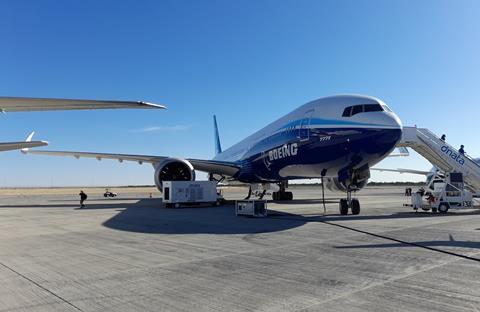Boeing is edging towards type inspection authorisation from the US FAA for its 777-9, the point at which it will commence the formal certification testing demonstration for the twinjet.
The airframer has brought its WH001 test aircraft to the show, which carries several engineering stations as well as a dozen water ballast tanks for weight and balance simulation.
“We’ve paperwork to finish up and some analysis we’re trying to close out before we get that TIA,” said 777-9 lead test pilot Capt Heather Ross, speaking to FlightGlobal during the Dubai air show.
“Once we get that TIA we can actually begin the [certification] flight-testing portion.” But she insists the airframer has already gone beyond the relatively narrow subset of regulatory tests during its extensive campaign.
Among the recent work have been minimum-unstick tests, earlier this year at Edwards air force base – a “big milestone”, says Ross, adding that there is “little bit more work to clean up” on landing-performance and braking checks.
“We’ve had good progress on all the testing, to be honest,” she adds.
Ross says the TIA is likely to involve repeating a number of the tests – such as take-off performance – that Boeing has already conducted. “There’s a couple of different ways to meet certification requirements,” she says. “Some of it is to have FAA personnel on board, and demonstrate those conditions, sometimes it’s a matter of getting credit for testing we’ve already completed.”

Route-proving, which is typically carried out in conjunction with customers, is further down the line, along with certain function-and-reliability checks and tests for extended twin-engined operations – although Ross points out that the 15h 40min flight from Seattle to Dubai illustrates the jet’s capabilities. The fuel-burn from the huge General Electric GE9X engines, she says, was “wonderful”.
Although Ross feels there is “more [regulatory] visibility”, she adds: “We do more in our own testing than is required from the FAA or any other regulator.
“So we’re operating with this big bubble of margin for performance and capability. I think there’s more focus because of today’s environment versus three years ago…but the whole Boeing shell of operations is just impressive, and everybody is focused on one thing and that’s safety.
While the 777-9 will be certified as a 777 derivative, it will feature both visible and less-visible updates from its predecessor.
Cockpit touchscreens – with thumb-divots in the frames, or a cursor control, in case of turbulence – are among the changes, and mark the first evolution of such technology for the Boeing fleet. While the -9 retains the legacy hydraulics, electrics and pneumatics, the flight-control system is the same design as the 787’s. “You don’t see that and the pilot doesn’t have to fly differently,” says Ross. “This airplane uses the same flight-control law as a 787.”
The 777-9 retains the electrical load-management system, but adopts the option of the 787’s head-up displays. It will employ modal suppression for “ride quality”, says Ross, using various flight surfaces. She adds that the aircraft features such enhancements as auto-start: “Systems that were more manual on 777 are now automated on this airplane.”
Aside from the longer fuselage and GE9X engines, the most obvious change is the folding wing-tips, which provide additional lift while allowing the jet to remain within airport gate constraints.
Ross says the test regime will not include folded wing-tips in flight. “There’s no despatchable configuration that allows takeoff with the wing-tips up,” she insists. “We have very specific deterrents for the crew in case they attempt to take off with wing-tips up.”
She points out that the ‘fold’ switch is “totally depowered” during flight and, besides, the wing-tips are “physically locked out”, adding: “There’s a pin about the size of your head that goes through the hinge of the wing-tip. It’s physically impossible to fold in flight.”





























